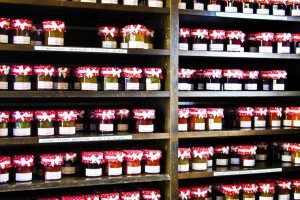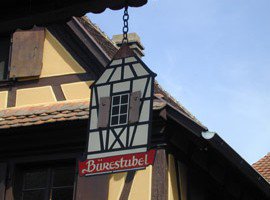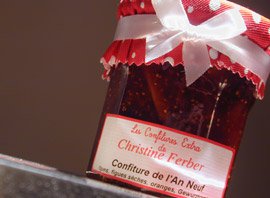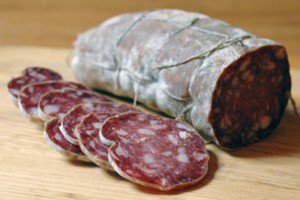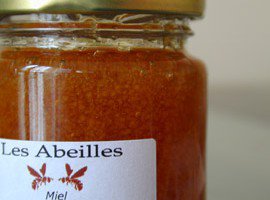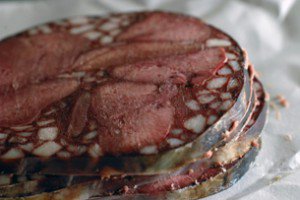
The house my parents own in the Vosges (a mountain range in the East of France, if you haven’t been following this blog as closely as you should) is located outside a small town called La Bresse. When we’re there on vacation, part of the food shopping is conducted in La Bresse itself — at the grocery store for basics, and at a charcuterie and two different bakeries (one makes really excellent bread, the other has delicious cakes and brioches) — but the rest is bought at the food market held on Thursdays and Saturdays in Gérardmer, a slightly larger town in the next valley.
As is usually the case in French food markets, most of the stands sell fruits and vegetables. Last week, they all boasted beautiful crops of various berries — blueberries, raspberries and redcurrants (red or white, the white being, surprisingly, sweeter and milder in taste). The sheer volume of berries on display always amazes and delights me : in Paris, berries are treated like nuggets of gold, sold in teeny tiny little baskets and priced like they’re some sort of luxury item. In Gérardmer, those same berries are so plentiful that they are offered in whole crates or even in buckets. You can buy less of course, but the profusion of those delicate and delicious darlings, plucked fresh from the mother-bush just the day before, does make for an incredibly appetizing sight.
One of the local specialties is the Bonbon des Vosges, a small hard candy which can be made in many different flavors : fruit flavors (berries mostly), but also more woodsy, get-your-sinuses-cleared-up flavors like fir tree, eucalyptus, pine tree, bergamot… the most famous Bonbon des Vosges probably being the “Suc des Vosges” by “La Vosgienne”. Driving around the Vosges, you see many confiseries, small artisanal candy-making factories which you can sometimes visit, a unique opportunity to gaze in awe at huge vats of brightly colored molten sugar. The market in Gérardmer has several stands selling those bonbons, in piles of little bags (one flavor or mixed flavors) stacked along the stand. Each flavor stack has a little cup of broken candy for you to taste, and one of the stand owners — the kindest — always insists you do. “Can’t buy it if you haven’t tasted it, that’s the rule!”
Another Vosgian specialty, like most mountainous regions, is honey. Several stands sell their production, the jars arranged in pyramids on a long table : different sorts of honey, and different types of derived products or remedies. This is where, on a previous occasion, I bought my favorite kind of honey, blessed with the poetic name of miel de printemps. This honey is produced in the spring only, it is white and opaque, which clearly differenciates it from the others, and it has the best texture ever, creamy and slightly grainy. It has a mild and flowery taste, with no bitterness at all. All the stands have you to taste the different honeys (with the requisite mini ice-cream spoons), but one of those stands won my heart by offering (for a symbolic price, really) tiny sample-size pots of honey, for you to try in the privacy of your own home, on different kinds of bread, in different moods, to see which one you really like best.
I bought no honey this time, but what I did buy was some pain d’épices, that typically French honey spice cake I’ve mentioned before (mine is the large piece on the picture, the other one, more reasonably-sized, is my sister’s). I spotted it not at a honey stand but at a charcuterie stand : a big hunk, of a promising golden brown color, which looked as if it had been much larger moments before but had had excellent success with the previous visitors. I asked for us to taste a sliver : I thought I had found my favorite pain d’épices at Les Abeilles recently, but this one was even better, moist, with complex and subtle flavors, utterly delicious. The stand owner explained that it was made by an Alsacian apiculteur, with organic flour, 55% of honey (to the exclusion of any other sweetener) and 20 spices. I, ever the inquirer, tried to get him to list the twenty spices but he said they were a secret kept by the producer. I suspect, rather, that he just had no idea, but I can hardly hold that against him (besides, I’m very probably the first person to ever ask).
There are quite a few charcuterie stands, too, selling jambons and saucissons (hams and dry sausages) in all shapes and flavors. One of them sold products from Savoie, a region of the Alps, and the stand owner was very generous with samples : we tasted dry-cured ham (as delicious as the one I had bought at the Salon Saveur), saucisson de chevreuil (from venison meat), saucisson aux girolles (with chanterelles), and saucisson aux fines herbes (with herbs). The latter was my favorite, and we got one such sauciflard — slang for “saucisson”.
We also had to get some cheese of course, as the region has quite a few specialties to be proud of : we got three, all cow’s milk (pictured here, clockwise from the bottom) : a Munster Fermier, a piece of Tomme des Vosges, and a slice of Tomme de Munster, which is a “pâte cuite” version of the traditional Munster.
We made a final stop at the stand of a small Alsacian wine producer, my father’s favorite, who, incidently has extended my parents a standing invitation to come to the winery and taste his wife’s kouglof (the Alsacian brioche). Hope I can come along for the ride when they do. We got a bottle of Tokay Pinot Gris, and two of Riesling Cuvée Première Neige (this means that the grapes are harvested late in the year — at the first signs of snow — so their sugar content is high, and the alcohol content of the wine, subsequently, is higher too). Both of these we had tasted at the house before, and very much enjoyed.
And after all this, after tasting all these saucissons and cheeses and candy and pain d’épice — not necessarily in that order — we drove to the lake, where Maxence and I went for a little pedal-boat ride in the sunshine, while my parents and sister had coffee on the terrace of the lakeside café. And let me tell you, bringing all these goodies back to Paris on the train without having all our neighbors faint from the smell (or throw us out) was no small feat. But I suspect every other passenger was guiltily hoarding a similar bounty and no one said a thing.


